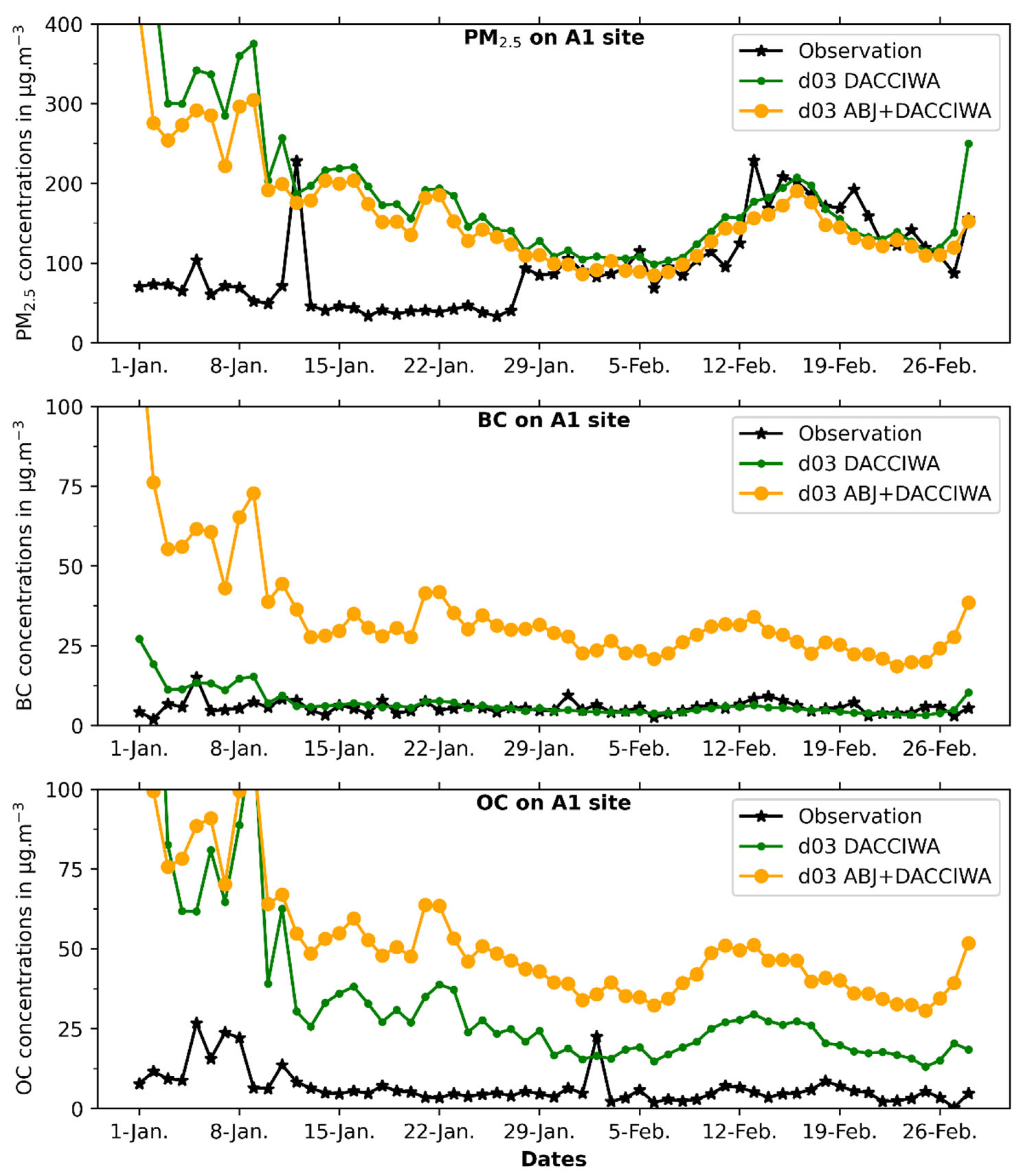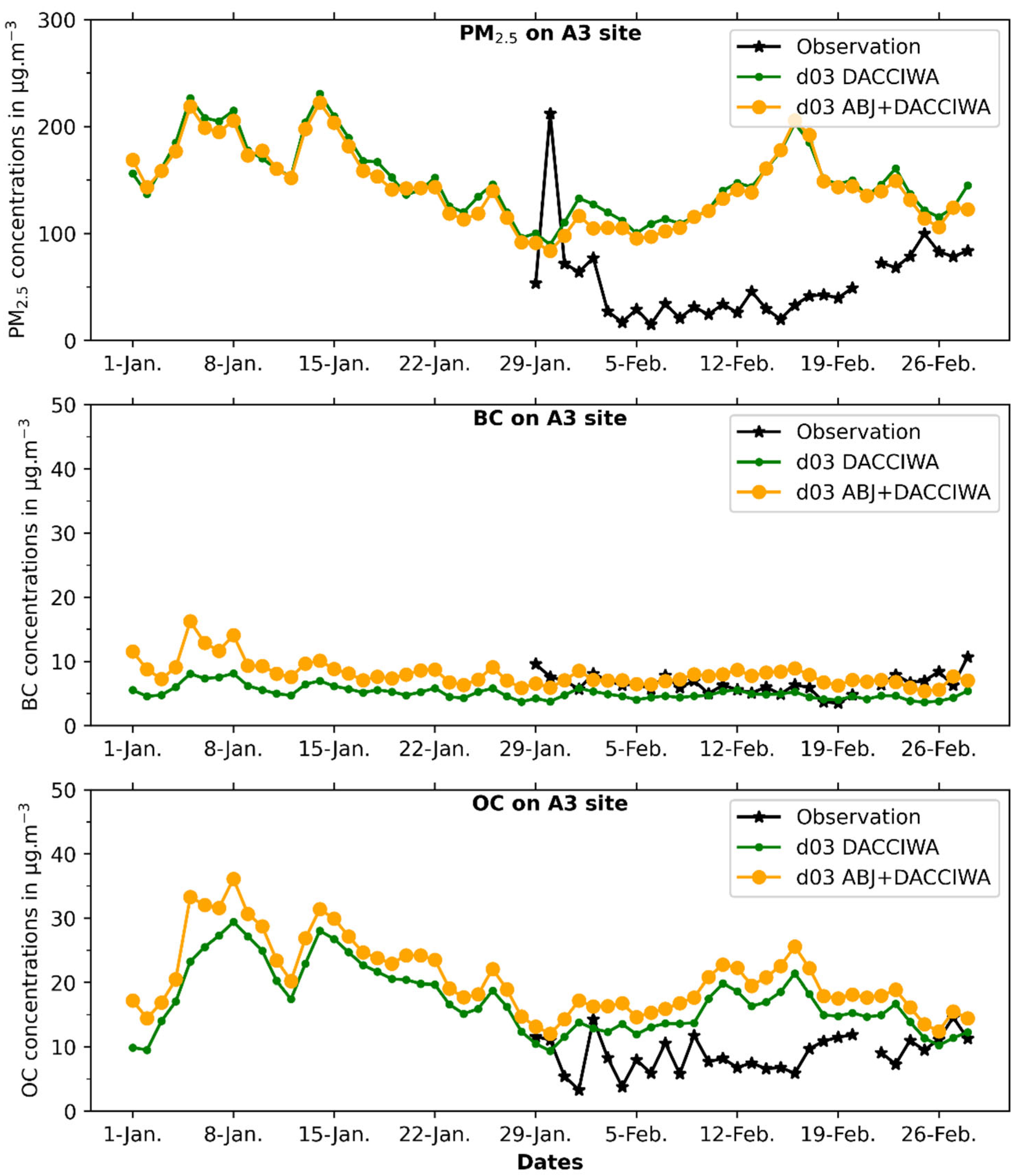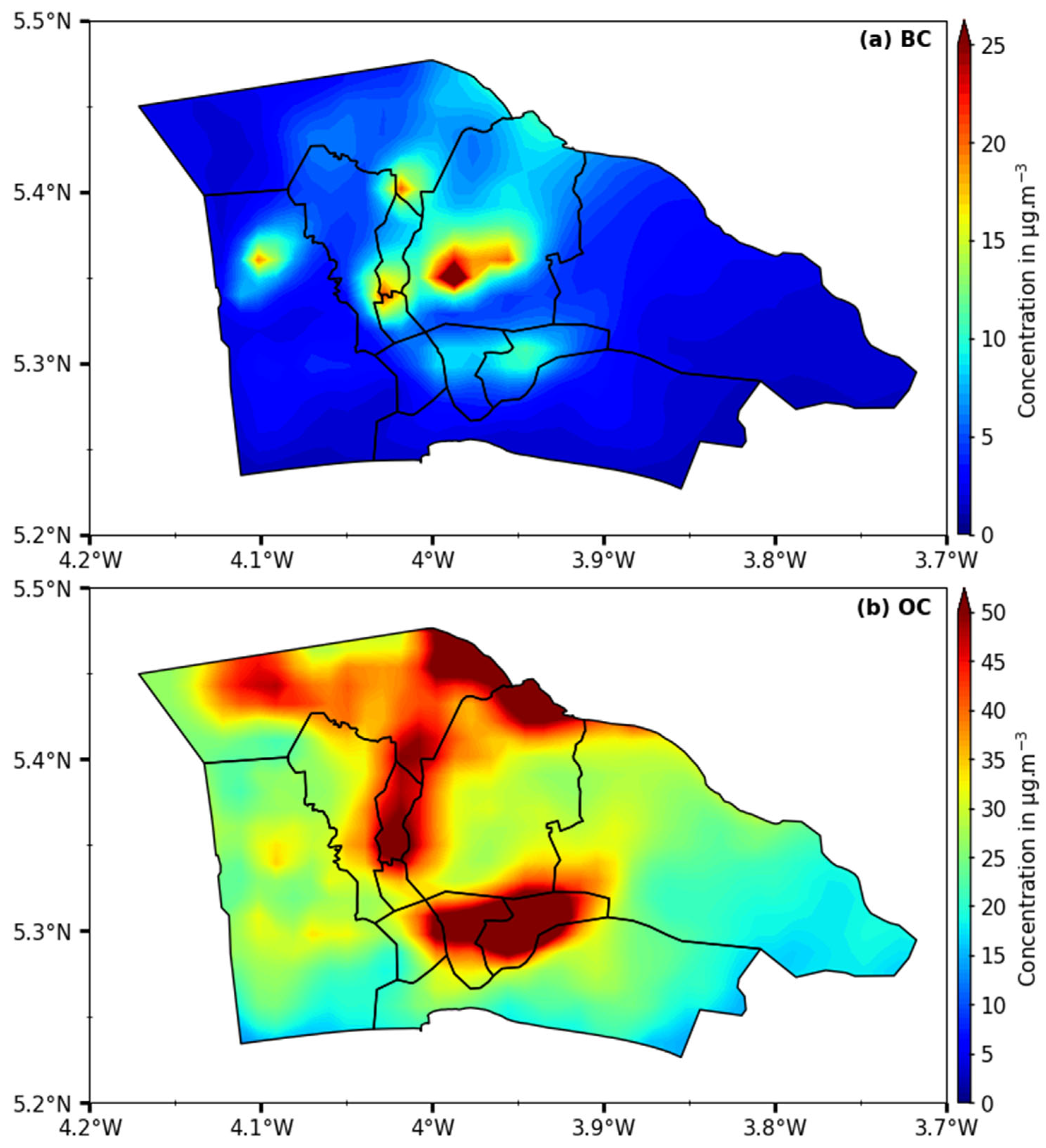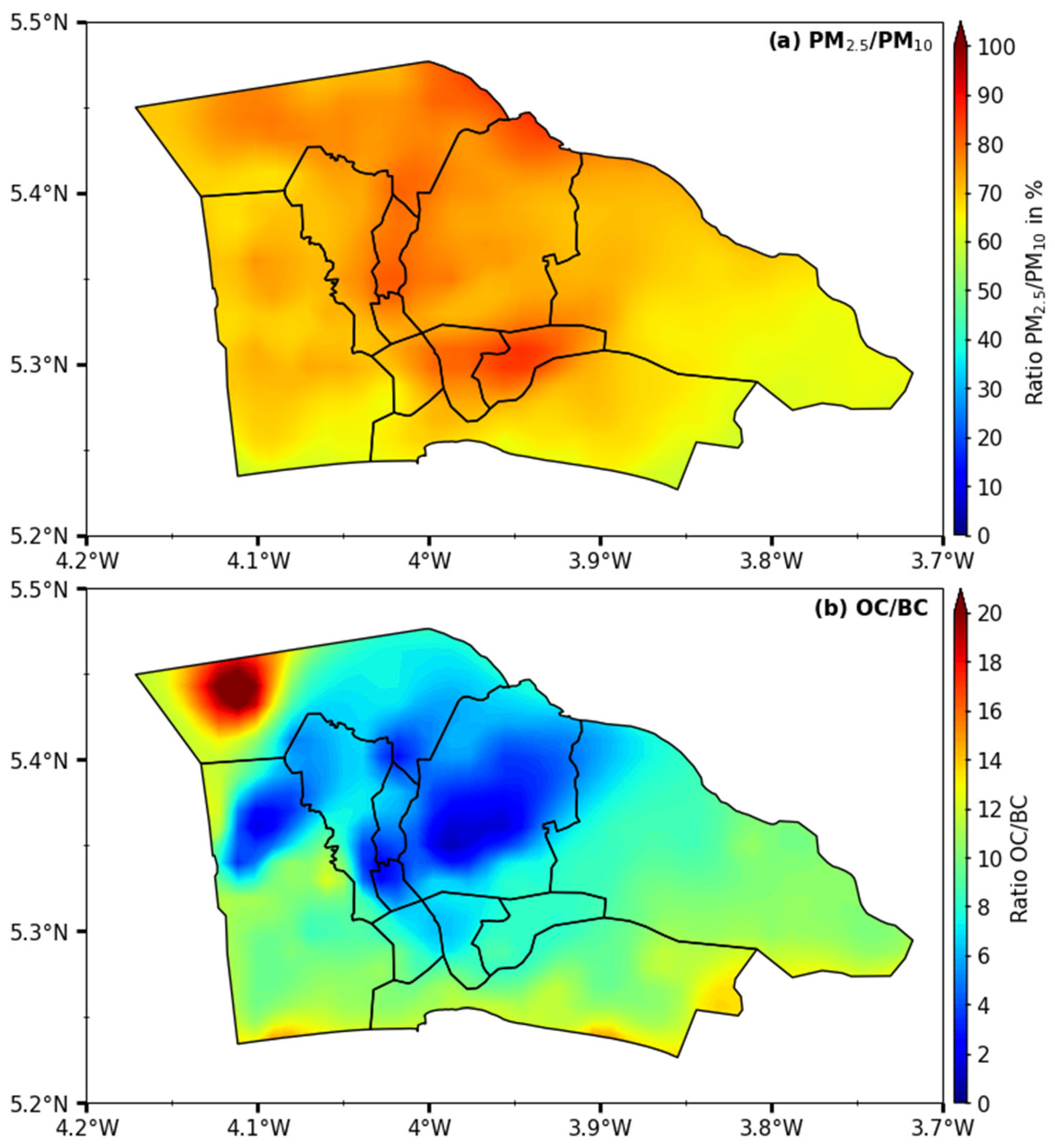High-Resolution Modeling of Air Quality in Abidjan (Côte d’Ivoire) Using a New Urban-Scale Inventory
Abstract
:1. Introduction
2. Materials and Methods
2.1. Study Areas
2.2. Methodology Used to Develop a City-Scale Anthropogenic Emission Inventory
2.2.1. Road Traffic Emission Source
2.2.2. Domestic Fire Emission Source
2.2.3. Industrial and Power Plant Emission Sources
2.2.4. Landfill Fire Source
2.3. WRF-Chem Model Description and Parametrization
2.3.1. Description of the Model
2.3.2. Domains of Simulations
2.3.3. Model Input
| Model Input | References |
|---|---|
| Cloud microphysics | Thompson microphysics [43] |
| Surface layer | MYNN surface layer |
| Earth surface model | Noah-MP land surface [44] |
| Planetary boundary layer | MYNN 2.5 scheme [45] |
| Cumulus parameterization | Grell-Freitas [46] |
| Radiation (short and long waves) | RRTMG [47] |
| Dust emissions | Ginoux et al. [39] |
| Sea salt emissions | Gong et al. [41] |
| Aerosol processes | GOCART aerosol module [39,40] |
| Biomass burning emissions | FINN [42] |
| Regional anthropogenic emissions | DACCIWA inventory [6] |
| Urban anthropogenic emissions | This work |
2.3.4. Modeled PM10 and PM2.5 Concentrations
2.3.5. The Cases Studied in Our Simulations
3. Results and Discussion
3.1. Emissions Inventory of the City of Abidjan
3.1.1. BC, OC, and SO2 Emissions in Abidjan
3.1.2. Spatialized BC and OC Emissions
3.2. Evaluation of City-Scale Modeling
3.2.1. Evaluation of City-Scale Modeling vs. Observations
3.2.2. Spatial Evaluation of the Model Results
3.3. Spatial Variation Maps
3.3.1. Spatial Variation Maps of PM2.5 and PM10 Concentrations
3.3.2. Spatial Variation Maps of BC and OC Concentrations
3.3.3. Spatial Variation Maps of the Contribution of PM2.5 to PM10 Concentrations and of OC/EC Ratios
4. Summary and Conclusions
Author Contributions
Funding
Institutional Review Board Statement
Informed Consent Statement
Data Availability Statement
Acknowledgments
Conflicts of Interest
References
- Guillaume, B.; Liousse, C.; Rosset, R.; Cachier, H.; Van Velthoven, P.; Bessagnet, B.; Poisson, N. ORISAM-TM4: A New Global Sectional Multi-Component Aerosol Model Including SOA Formation—Focus on Carbonaceous BC and OC Aerosols. Tellus B 2007, 59, 283–302. [Google Scholar] [CrossRef]
- Liousse, C.; Guillaume, B.; Grégoire, J.M.; Mallet, M.; Galy, C.; Pont, V.; Akpo, A.; Bedou, M.; Castéra, P.; Dungall, L.; et al. Updated African Biomass Burning Emission Inventories in the Framework of the AMMA-IDAF Program, with an Evaluation of Combustion Aerosols. Atmos. Chem. Phys. 2010, 10, 9631–9646. [Google Scholar] [CrossRef]
- Malavelle, F.; Mallet, M.; Pont, V.; Liousse, C.; Solmon, F. Long-Term Simulations (2001–2006) of Biomass Burning and Mineral Dust Optical Properties over West Africa: Comparisons with New Satellite Retrievals. Atmos. Chem. Phys. 2011, 11, 28587–28626. [Google Scholar] [CrossRef]
- Menut, L.; Bessagnet, B.; Khvorostyanov, D.; Turquety, S.; Monge, J.-L.; Valari, M.; Vautard, R. Modélisation de La Composition Chimique de La Troposphère Avec CHIMERE. Météorologie 2011, 8, 23. [Google Scholar] [CrossRef]
- Liousse, C.; Assamoi, E.; Criqui, P.; Granier, C.; Rosset, R. Explosive Growth in African Combustion Emissions from 2005 to 2030. Environ. Res. Lett. 2014, 9, 035003. [Google Scholar] [CrossRef]
- Keita, S.; Liousse, C.; Assamoi, E.-M.; Doumbia, T.; N’Datchoh, E.T.; Gnamien, S.; Elguindi, N.; Granier, C.; Yoboué, V. African Anthropogenic Emissions Inventory for Gases and Particles from 1990 to 2015. Earth Syst. Sci. Data 2021, 13, 3691–3705. [Google Scholar] [CrossRef]
- WHO. Lignes Directrices OMS Relatives à la Qualité de L’air: Particules, Ozone, Dioxyde D’azote et Dioxyde de Soufre; Organisation Mondiale de la Santé: Genève, Switzerland, 2021. [Google Scholar]
- Adon, A.J.; Liousse, C.; Doumbia, E.T.; Baeza-Squiban, A.; Cachier, H.; Léon, J.-F.; Yoboue, V.; Akpo, A.B.; Galy-Lacaux, C.; Zoutien, C.; et al. Physico-Chemical Characterization of Urban Aerosols from Specific Combustion Sources in West Africa at Abidjan in Côte d’Ivoire and Cotonou in Benin in the Frame of DACCIWA Program. Atmos. Chem. Phys. 2020, 20, 1–69. [Google Scholar] [CrossRef]
- Djossou, J.; Léon, J.-F.; Akpo, A.B.; Liousse, C.; Yoboué, V.; Bedou, M.; Bodjrenou, M.; Chiron, C.; Galy-Lacaux, C.; Gardrat, E.; et al. Mass Concentration, Optical Depth and Carbon Composition of Particulate Matter in the Major Southern West African Cities of Cotonou (Benin) and Abidjan (Côte d’Ivoire). Atmos. Chem. Phys. 2018, 18, 6275–6291. [Google Scholar] [CrossRef]
- Gnamien, S.; Liousse, C.; Keita, S.; Silue, S.; Bahino, J.; Gardrat, E.; Kassamba-Diaby, M.L.; Ochou, A.; Yoboue, V. Chemical Characterization of Urban Aerosols in Abidjan and Korhogo (Cote d’Ivoire) from 2018 to 2020 and Identification of Their Potential Emission Sources. Environ. Sci. Atmos. 2023, 3, 1741–1757. [Google Scholar] [CrossRef]
- Gnamien, S.; Yoboué, V.; Liousse, C.; Ossohou, M.; Keita, S.; Bahino, J.; Siélé, S.; Diaby, L. Particulate Pollution in Korhogo and Abidjan (Cote d’Ivoire) during the Dry Season. Aerosol Air Qual. Res. 2020, 21, 19. [Google Scholar] [CrossRef]
- Bahino, J.; Yoboué, V.; Galy-Lacaux, C.; Adon, M.; Akpo, A.; Keita, S.; Liousse, C.; Gardrat, E.; Chiron, C.; Ossohou, M.; et al. A Pilot Study of Gaseous Pollutants’ Measurement (NO2, SO2, NH3, HNO3 and O3) in Abidjan, Côte d’Ivoire: Contribution to an Overview of Gaseous Pollution in African Cities. Atmos. Chem. Phys. 2018, 18, 5173–5198. [Google Scholar] [CrossRef]
- Keita, S.; Liousse, C.; Yoboué, V.; Dominutti, P.; Guinot, B.; Assamoi, E.-M.; Borbon, A.; Haslett, S.L.; Bouvier, L.; Colomb, A.; et al. Particle and VOC Emission Factor Measurements for Anthropogenic Sources in West Africa. Atmos. Chem. Phys. 2018, 18, 7691–7708. [Google Scholar] [CrossRef]
- Doumbia, M.; Kouassi, A.A.; Silué, S.; Yoboué, V.; Liousse, C.; Diedhiou, A.; Touré, N.E.; Keita, S.; Assamoi, E.-M.; Bamba, A.; et al. Road Traffic Emission Inventory in an Urban Zone of West Africa: Case of Yopougon City (Abidjan, Côte d’Ivoire). Energies 2021, 14, 1111. [Google Scholar] [CrossRef]
- Doumbia, M.; Toure, N.; Silue, S.; Yoboue, V.; Diedhiou, A.; Hauhouot, C. Emissions from the Road Traffic of West African Cities: Assessment of Vehicle Fleet and Fuel Consumption. Energies 2018, 11, 2300. [Google Scholar] [CrossRef]
- Kassamba-Diaby, M.L.; Galy-Lacaux, C.; Yoboué, V.; Hickman, J.E.; Mouchel-Vallon, C.; Jaars, K.; Gnamien, S.; Konan, R.; Gardrat, E.; Silué, S. The Chemical Characteristics of Rainwater and Wet Atmospheric Deposition Fluxes at Two Urban Sites and One Rural Site in Côte d’Ivoire. Atmosphere 2023, 14, 809. [Google Scholar] [CrossRef]
- Konan, B.R.; Yoboue, V.; Adiaffi, B.; Diaby, M.; Oga, Y.M.S.; Bakayoko, A.; Gnamien, S.; Keita, S.; Bahino, J.; Ossohou, M. Source of Polycyclic Aromatic Hydrocarbons (PAHs) in Rainwater and Effect on the Health of the Population: The Case of the District of Abidjan in the South of Ivory Coast. J. Water Health 2022, 20, 985–1004. [Google Scholar] [CrossRef] [PubMed]
- Coulibaly, M.; Attoh-Toure, H.; Kouao, A.R.K.; Kouassi, D.P.; Yéo, S.; Yoboue, V.; Tiembré, I. Impairment in Lung Function among Residents in the Vicinity of an Artisanal Smoking Site in Abidjan Côte d’Ivoire. J. Community Med. Public Health Rep. 2021, 2, 1–9. [Google Scholar] [CrossRef]
- Evilafo, L.; Kéita, S.; Bahino, J.; Koffi, U.; Koffi, E.; Coulibaly, K.; Yoboue, V.; Ossey, Y.; Djaman, J.; Anin Atchibri, L.; et al. Link between the Combustion of Household Waste from Akouédo Landfill, Air Quality and Vitamin A Status among Residents. J. Mater. Environ. Sci. 2019, 10, 1310–1323. [Google Scholar]
- Kouao, A.R.K.; N’datchoh, E.T.; Yoboue, V.; Silue, S.; Attoh, H.; Coulibaly, M.; Robins, T. Exposure to Indoor and Outdoor Air Pollution among Children under Five Years Old in Urban Area. GJESM 2019, 5, 191–202. [Google Scholar] [CrossRef]
- Kouao, A.R.K.; Kouadio, K.; Toure, A.H.; Coulibaly, M. Prevalence of Asthma in Children under 5 Years Old Exposed to Air Pollution in Abidjan, (Côte d’Ivoire). Int. J. Recent Sci. Res. 2019, 10, 33353–33358. [Google Scholar]
- DACCIWA Project. Deliverable D 2.5 Inflammatory Risk Regional Maps of Dynamics-Aerosol-Chemistry-Cloud Interactions in West Africa Project; Karlsruher Institut für Technologie: Karlsruhe, Germany, 2019. [Google Scholar]
- Deroubaix, A.; Menut, L.; Flamant, C.; Brito, J.; Denjean, C.; Dreiling, V.; Fink, A.; Jambert, C.; Kalthoff, N.; Knippertz, P.; et al. Diurnal Cycle of Coastal Anthropogenic Pollutant Transport over Southern West Africa during the DACCIWA Campaign. Atmos. Chem. Phys. 2019, 19, 473–497. [Google Scholar] [CrossRef]
- Liousse, C.; Toure, N.; Roblou, L.; Baeza-Squiban, A.; Annesi-Maesano, I. Dynamics-Aerosol-Chemistry-Cloud Interactions in West Africa—Inflammatory Risk Regional Maps; Karlsruher Institut für Technologie: Karlsruhe, Germany, 2019. [Google Scholar]
- Junker, C.; Liousse, C. A Global Emission Inventory of Carbonaceous Aerosol from Historic Records of Fossil Fuel and Biofuel Consumption for the Period 1860–1997. Atmos. Chem. Phys. 2008, 8, 1195–1207. [Google Scholar] [CrossRef]
- Konan, Y.G.; Echui, A.D.; Conférence CODATU XVII. Presented at the Mobilité Intelligente, Inclusive et Soutenable Hyderabad. Conférence CODATU XVII, Institute of urban transport, Inde. 2017. Available online: https://www.itf-oecd.org/codatu-xvii-conference (accessed on 22 July 2020).
- N’guessan, K.N.; N’guessan, Y.; Diango, K.A.; Perilhon, C.; Sako, M.K.; Saraka, K.J. Energy and Environmental Impact of the Abidjanese Way of Life (Côte D’ivoire): A Case Study of Energy Efficiency of Transport Modes. AIP Conf. Proc. 2020, 2307, 020012. [Google Scholar]
- RGPH. Indicateurs Démographiques; Institut National de la Statistique: Abidjan, Côte d’Ivoire, 2014. [Google Scholar]
- Columbia University Center for International Earth Science Information Network (CIESIN). 2020. Available online: http://www.ciesin.org (accessed on 23 August 2021).
- Wiedinmyer, C.; Yokelson, R.J.; Gullett, B.K. Global Emissions of Trace Gases, Particulate Matter, and Hazardous Air Pollutants from Open Burning of Domestic Waste. Environ. Sci. Technol. 2014, 48, 9523–9530. [Google Scholar] [CrossRef]
- Grell, G.A.; Peckham, S.E.; Schmitz, R.; McKeen, S.A.; Frost, G.; Skamarock, W.C.; Eder, B. Fully Coupled “Online” Chemistry within the WRF Model. Atmos. Environ. 2005, 39, 6957–6975. [Google Scholar] [CrossRef]
- Fast, J.D.; Gustafson, W.I.; Easter, R.C.; Zaveri, R.A.; Barnard, J.C.; Chapman, E.G.; Grell, G.A.; Peckham, S.E. Evolution of Ozone, Particulates, and Aerosol Direct Radiative Forcing in the Vicinity of Houston Using a Fully Coupled Meteorology-Chemistry-Aerosol Model. J. Geophys. Res. 2006, 111, D21305. [Google Scholar] [CrossRef]
- Kuik, F.; Lauer, A.; Beukes, J.P.; Van Zyl, P.G.; Josipovic, M.; Vakkari, V.; Laakso, L.; Feig, G.T. The Anthropogenic Contribution to Atmospheric Black Carbon Concentrations in Southern Africa: A WRF-Chem Modeling Study. Atmos. Chem. Phys. 2015, 15, 8809–8830. [Google Scholar] [CrossRef]
- Kumar, A.; Jiménez, R.; Belalcázar, L.C.; Rojas, N.Y. Application of WRF-Chem Model to Simulate PM10 Concentration over Bogota. Aerosol Air Qual. Res. 2016, 16, 1206–1221. [Google Scholar] [CrossRef]
- Adefisan, E.A.; Jovita Oghaego, A. Performance Evaluation of WRF-CHEM in Simulating Harmattan Dust over West Africa. J. Climatol. Weather Forecast 2018, 6, 16. [Google Scholar] [CrossRef]
- Jenkins, G.S.; Gueye, M. WRF 1960–2014 Winter Season Simulations of Particulate Matter in the Sahel: Implications for Air Quality and Respiratory Health. GeoHealth 2018, 2, 248–260. [Google Scholar] [CrossRef]
- Do, T.N.N.; Ngo, X.T.; Pham, V.H.; Vuong, N.L.; Le, H.A.; Pham, C.T.; Bui, Q.H.; Nguyen, T.N.T. Application of WRF-Chem to Simulate Air Quality over Northern Vietnam. Environ. Sci. Pollut. Res. 2021, 28, 12067–12081. [Google Scholar] [CrossRef] [PubMed]
- Buchholz, R.R.; Emmons, L.K.; Tilmes, S.; The CESM2 Development Team. CESM2.1/CAM-Chem Instantaneous Output for Boundary Conditions. 2019. Available online: https://wiki.ucar.edu/pages/viewpage.action?pageId=372834733 (accessed on 23 August 2021).
- Ginoux, P.; Chin, M.; Tegen, I.; Prospero, J.M.; Holben, B.; Dubovik, O.; Lin, S.-J. Sources and Distributions of Dust Aerosols Simulated with the GOCART Model. J. Geophys. Res. Atmos. 2001, 106, 20255–20273. [Google Scholar] [CrossRef]
- Chin, M.; Ginoux, P.; Kinne, S.; Torres, O.; Holben, B.N.; Duncan, B.N.; Martin, R.V.; Logan, J.A.; Higurashi, A.; Nakajima, T. Tropospheric Aerosol Optical Thickness from the GOCART Model and Comparisons with Satellite and Sun Photometer Measurements. J. Atmos. Sci. 2002, 59, 461–483. [Google Scholar] [CrossRef]
- Gong, S.L.; Barrie, L.A.; Blanchet, J.-P. Modeling Sea-Salt Aerosols in the Atmosphere: 1. Model Development. J. Geophys. Res. Atmos. 1997, 102, 3805–3818. [Google Scholar] [CrossRef]
- Freitas, S.R.; Longo, K.M.; Chatfield, R.; Latham, D.; Silva Dias, M.a.F.; Andreae, M.O.; Prins, E.; Santos, J.C.; Gielow, R.; Carvalho, J.A.J. Including the Sub-Grid Scale Plume Rise of Vegetation Fires in Low Resolution Atmospheric Transport Models. Atmos. Chem. Phys. 2007, 7, 3385–3398. [Google Scholar] [CrossRef]
- Thompson, G.; Field, P.R.; Rasmussen, R.M.; Hall, W.D. Explicit Forecasts of Winter Precipitation Using an Improved Bulk Microphysics Scheme. Part II: Implementation of a New Snow Parameterization. Mon. Weather. Rev. 2008, 136, 5095–5115. [Google Scholar] [CrossRef]
- Niu, G.-Y.; Yang, Z.-L.; Mitchell, K.E.; Chen, F.; Ek, M.B.; Barlage, M.; Kumar, A.; Manning, K.; Niyogi, D.; Rosero, E.; et al. The Community Noah Land Surface Model with Multiparameterization Options (Noah-MP): 1. Model Description and Evaluation with Local-Scale Measurements. J. Geophys. Res. 2011, 116, D12109. [Google Scholar] [CrossRef]
- Nakanishi, M.; Niino, H. Development of an Improved Turbulence Closure Model for the Atmospheric Boundary Layer. J. Meteorol. Soc. Jpn. Ser. II 2009, 87, 895–912. [Google Scholar] [CrossRef]
- Grell, G.A.; Freitas, S.R. A Scale and Aerosol Aware Stochastic Convective Parameterization for Weather and Air Quality Modeling. Atmos. Chem. Phys. 2014, 14, 5233–5250. [Google Scholar] [CrossRef]
- Iacono, M.J.; Delamere, J.S.; Mlawer, E.J.; Shephard, M.W.; Clough, S.A.; Collins, W.D. Radiative Forcing by Long-Lived Greenhouse Gases: Calculations with the AER Radiative Transfer Models. J. Geophys. Res. 2008, 113, D13103. [Google Scholar] [CrossRef]
- Gueye, M.; Jenkins, G.S. Investigating the Sensitivity of the WRF-Chem Horizontal Grid Spacing on PM10 Concentration during 2012 over West Africa. Atmos. Environ. 2019, 196, 152–163. [Google Scholar] [CrossRef]
- Sicard, P.; Crippa, P.; De Marco, A.; Castruccio, S.; Giani, P.; Cuesta, J.; Paoletti, E.; Feng, Z.; Anav, A. High Spatial Resolution WRF-Chem Model over Asia: Physics and Chemistry Evaluation. Atmos. Environ. 2021, 244, 118004. [Google Scholar] [CrossRef]
- Žabkar, R.; Honzak, L.; Skok, G.; Forkel, R.; Rakovec, J.; Ceglar, A.; Žagar, N. Evaluation of the High Resolution WRF-Chem (v3.4.1) Air Quality Forecast and Its Comparison with Statistical Ozone Predictions. Geosci. Model Dev. 2015, 8, 2119–2137. [Google Scholar] [CrossRef]










| Vehicle Category (Use) | Specific Fuel Consumption (lep/100 km) * | Energy | Average Distance Traveled (km) ** |
|---|---|---|---|
| Passenger car (personal car) | 10.98 | Gasoline | 13,002.6 |
| Diesel | 16,297.5 | ||
| Light-duty vehicle (gbaka) | 16.72 | Gasoline | 15,315.3 |
| Diesel | 24,401.9 | ||
| Passenger car (taxi) | 11.40 | Gasoline | 53,124.2 |
| Diesel | 59,694.3 | ||
| Passenger car (intercommunal taxi) | 14.77 | Gasoline | 53,124.2 |
| Diesel | 59,694.3 | ||
| Passenger car (communal taxi) | 17.00 | Gasoline | 53,124.2 |
| Diesel | 59,694.3 | ||
| Urban bus | 47.36 | Diesel | 107,197.6 |
| Heavy-duty vehicle | 47.36 | Diesel | 84,525.6 |
| Vehicle Category | Energy | Age Range | Emission Factors (g/kg of Fuel) * | |
|---|---|---|---|---|
| BC | OC | |||
| Two wheels | Gasoline | All | 2.13 | 28.46 |
| Light-duty vehicle (personal car, gbaka, and taxi) | Gasoline | Recent | 0.001 | 0.042 |
| Gasoline | Old | 1.03 | 1.8 | |
| Diesel | Recent | 1.26 | 0.6 | |
| Diesel | Old | 4.74 | 2.97 | |
| Heavy-duty vehicle (urban bus and others) | Diesel | Recent | 0.35 | 0.72 |
| Diesel | Old | 3.43 | 3.71 | |
| Sources | Emissions (Gg) | ||
|---|---|---|---|
| BC | OC | SO2 | |
| Domestic fires | 1117.4 | 7719.5 | 483.8 |
| Traffic | 2198.8 | 2062.6 | 1624.8 |
| Landfill fires | 1428.6 | 4718.2 | 366.3 |
| Power plants | 22.3 | 66.4 | 138.5 |
| Industries | 219.6 | 164.7 | 5138.2 |
| Total | 4986.8 | 14,731.4 | 7751.6 |
| Simulation Domain | Simulated Inventory | RMSE (µg.m−3) | |
|---|---|---|---|
| PM10 | PM2.5 | ||
| d01 | DACCIWA | 62.0 | 48.8 |
| ABJ+DACCIWA | 45.8 | 31.2 | |
| d02 | DACCIWA | 86.5 | 69.4 |
| ABJ+DACCIWA | 62.8 | 48.8 | |
| d03 | DACCIWA | 63.9 | 78.8 |
| ABJ+DACCIWA | 52.9 | 68.2 | |
Disclaimer/Publisher’s Note: The statements, opinions and data contained in all publications are solely those of the individual author(s) and contributor(s) and not of MDPI and/or the editor(s). MDPI and/or the editor(s) disclaim responsibility for any injury to people or property resulting from any ideas, methods, instructions or products referred to in the content. |
© 2024 by the authors. Licensee MDPI, Basel, Switzerland. This article is an open access article distributed under the terms and conditions of the Creative Commons Attribution (CC BY) license (https://creativecommons.org/licenses/by/4.0/).
Share and Cite
Gnamien, S.; Liousse, C.; Keita, S.; Kumar, R.; Yoboué, V. High-Resolution Modeling of Air Quality in Abidjan (Côte d’Ivoire) Using a New Urban-Scale Inventory. Atmosphere 2024, 15, 758. https://doi.org/10.3390/atmos15070758
Gnamien S, Liousse C, Keita S, Kumar R, Yoboué V. High-Resolution Modeling of Air Quality in Abidjan (Côte d’Ivoire) Using a New Urban-Scale Inventory. Atmosphere. 2024; 15(7):758. https://doi.org/10.3390/atmos15070758
Chicago/Turabian StyleGnamien, Sylvain, Cathy Liousse, Sekou Keita, Rajesh Kumar, and Véronique Yoboué. 2024. "High-Resolution Modeling of Air Quality in Abidjan (Côte d’Ivoire) Using a New Urban-Scale Inventory" Atmosphere 15, no. 7: 758. https://doi.org/10.3390/atmos15070758
APA StyleGnamien, S., Liousse, C., Keita, S., Kumar, R., & Yoboué, V. (2024). High-Resolution Modeling of Air Quality in Abidjan (Côte d’Ivoire) Using a New Urban-Scale Inventory. Atmosphere, 15(7), 758. https://doi.org/10.3390/atmos15070758






